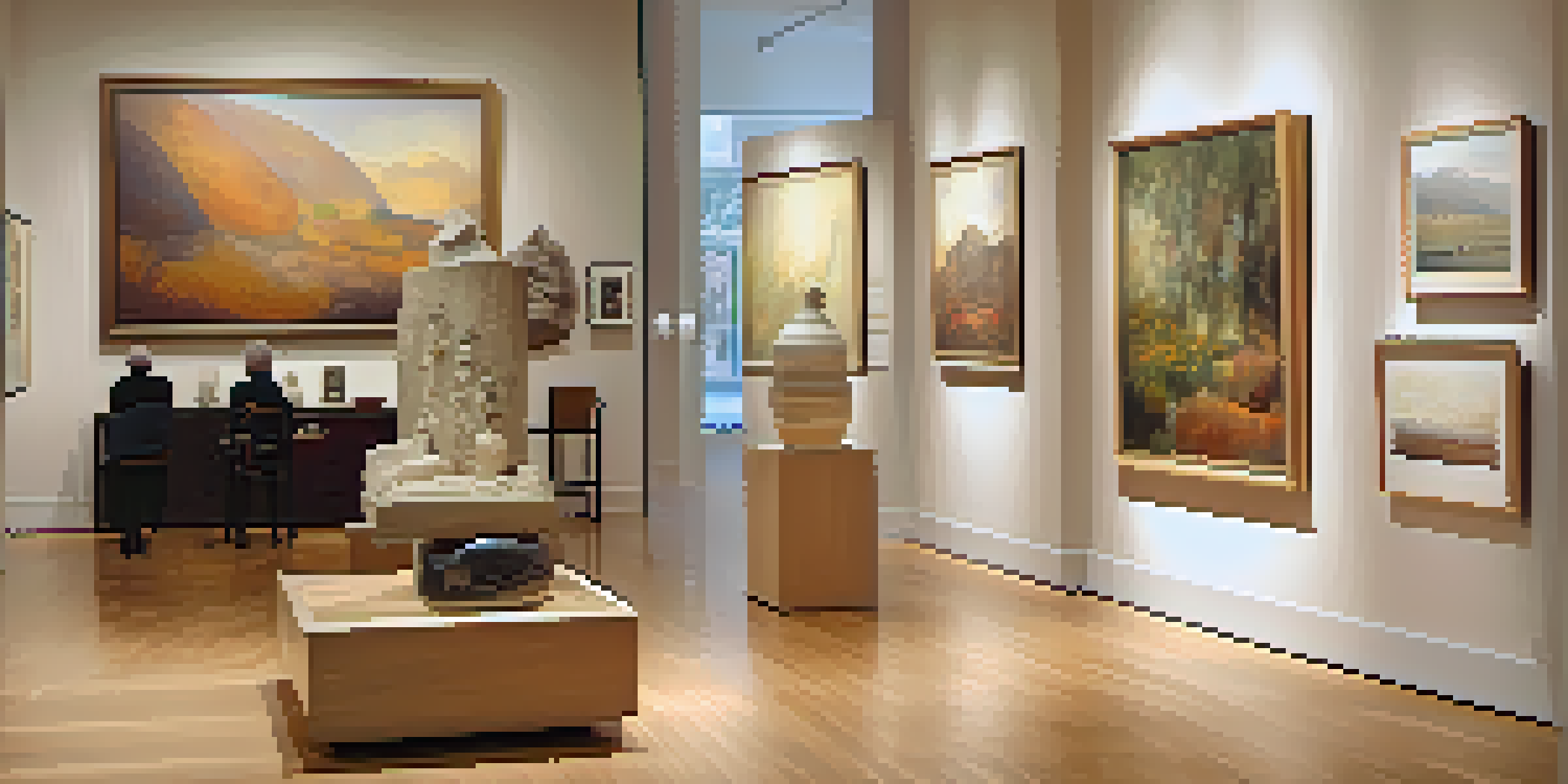Art Collectibles and Tax Implications: What Investors Should Know

Understanding Art Collectibles as Investments
Art collectibles, ranging from paintings to sculptures, have become popular investment options in recent years. Unlike traditional assets, art can provide both aesthetic pleasure and financial return, making it an attractive choice for investors. However, investing in art isn't just about picking pieces that resonate with you; it requires an understanding of market trends and potential value appreciation.
Art is not what you see, but what you make others see.
Many collectors start investing in art for the love of the craft but often find themselves drawn into the financial aspects as they realize the investment potential. As with any asset, the value of art can fluctuate based on demand, artist reputation, and market conditions. Thus, knowing what to look for in a collectible can make a significant difference in your investment strategy.
It's essential to approach art collecting with a well-rounded perspective, balancing emotional appeal with financial acumen. This dual approach can help ensure that your investment not only brings joy but also stands a chance of appreciating over time.
Tax Considerations for Art Collectibles
When it comes to art collectibles, understanding the tax implications is crucial for investors. Art is considered a capital asset, which means any profit made from selling art is subject to capital gains tax. This tax can vary depending on how long you’ve held the piece, with different rates applying for short-term versus long-term holdings.

For instance, if you sell a piece of art that you’ve owned for more than a year, you may qualify for long-term capital gains rates, which tend to be lower than short-term rates. This distinction is essential for maximizing your profits while minimizing tax liabilities. Proper planning can lead to significant tax savings, making it a vital aspect of your investment strategy.
Art as a Dual Investment
Investing in art requires balancing emotional appeal with financial insight to maximize both enjoyment and potential returns.
In addition to capital gains tax, you may also need to consider other tax implications, such as sales tax when purchasing art. Keeping thorough records of your art transactions, including purchase prices and dates, can help streamline the process during tax season.
Art Donations: Tax Benefits and Deductions
Donating art to a qualified charitable organization can yield significant tax benefits for investors. When you donate a piece of art, you may be eligible for a tax deduction based on the fair market value of the artwork at the time of the donation. This deduction can reduce your taxable income, ultimately leading to lower tax payments.
The best investment on Earth is earth.
However, it's crucial to ensure that the charity is properly qualified under IRS guidelines, as this can affect your ability to claim the deduction. Additionally, you may need to obtain a qualified appraisal to substantiate the fair market value, especially for high-value pieces. This process can seem daunting, but it often results in considerable tax savings.
When considering a donation, think about not just the financial impact, but also the positive contribution to your community or the arts. Supporting a cause you care about can add a fulfilling dimension to your investment strategy.
Tax Implications of Selling Art Collectibles
Selling your art collectibles can be a lucrative endeavor, but it’s essential to be aware of the tax implications that come with it. As mentioned earlier, profits from the sale of art are subject to capital gains tax, which can significantly impact your overall return on investment. Understanding this tax landscape before selling can help you make informed decisions about timing and pricing.
For example, if you know you’ll be in a lower tax bracket in the next year, you might consider holding onto your artwork a bit longer to minimize tax liabilities. Conversely, if you anticipate a higher tax bracket in the near future, selling sooner may be more beneficial. Timing your sale can be just as critical as the sale itself.
Tax Implications of Art Sales
Understanding capital gains tax and its nuances is essential for art investors to optimize profits when selling their collectibles.
Additionally, keeping detailed records of your purchases, sales, and any associated expenses can aid in accurately calculating your capital gains and ensuring compliance with tax regulations. A well-organized approach can make the selling process smoother and more profitable.
The Importance of Proper Valuation
Proper valuation of your art collectibles is vital, not just for investment decisions but also for tax purposes. Having an accurate assessment of your art’s fair market value can affect everything from insurance coverage to potential tax deductions or liabilities. It’s advisable to consult with a qualified appraiser to ensure you have a reliable valuation.
Valuation can be influenced by various factors, including the artist's reputation, the artwork's condition, and current market demand. Trends in the art market can shift, so regular appraisals can help track the value of your collection over time. Staying informed about market conditions can also prepare you for future sales.
Ultimately, accurate valuation helps you approach your investments with confidence and prepares you for potential tax implications. A well-valued collection not only enhances your portfolio but also provides peace of mind.
Navigating Art Market Regulations
The art market is subject to various regulations that can affect your investments and tax obligations. These regulations can vary significantly by country and can include rules about provenance, authenticity, and sales practices. Being aware of these regulations helps you navigate the complexities of buying and selling art collectibles.
For example, some countries may impose import/export regulations that affect how you sell or acquire art internationally. Understanding these rules can save you time, money, and potential legal headaches. Consulting with legal professionals who specialize in art law can provide essential guidance.
Legacy Planning for Art Collections
Proactively planning for the future of your art collection can ensure it serves as a meaningful legacy while minimizing tax burdens for heirs.
Additionally, being compliant with regulations can enhance your credibility as an investor and collector. Transparency in your transactions can build trust with buyers and sellers alike, ultimately benefiting your investment journey.
Planning for Future Generations: Art as Legacy
Investing in art can also be about legacy planning, ensuring that your collection is preserved for future generations. Consider how you want your art to be managed after your passing, which can involve estate planning and tax considerations. By proactively planning, you can help ensure that your loved ones can appreciate and benefit from your investments.
Establishing a clear plan for your collection can also minimize potential tax burdens for your heirs. For instance, transferring ownership of your art during your lifetime versus after your death can trigger different tax consequences. Consulting with financial advisors and estate planners can provide valuable insights into the best strategies for your unique situation.

Ultimately, your art collection can serve as a meaningful legacy that reflects your values and passions. By thoughtfully planning for its future, you can ensure that your investment continues to inspire and benefit others long after you're gone.